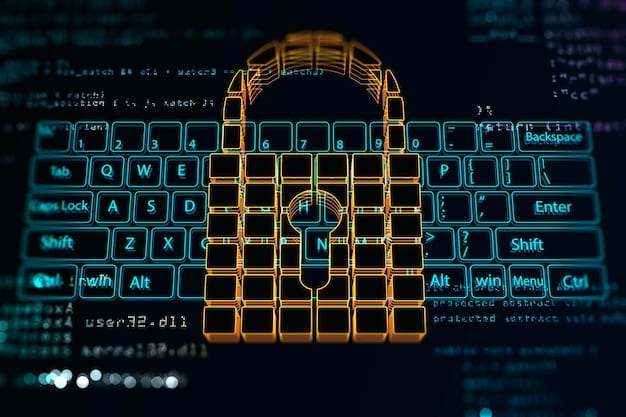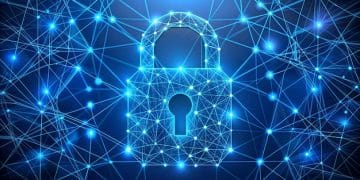Quantum Encryption: US Gov’t Data Security by 2025?

Anúncios
Quantum computing’s potential to revolutionize data encryption for US government agencies by 2025 hinges on overcoming technological hurdles and addressing security vulnerabilities, impacting national security and data privacy.
The looming threat of quantum computers breaking current encryption standards has sparked intense debate. Will quantum computing revolutionize data encryption for US government agencies by 2025? The answer is complex, involving technological advancements, security risks, and policy decisions.
Anúncios
Quantum Computing and Encryption: The Inevitable Collision
Quantum computing, leveraging the principles of quantum mechanics, presents unprecedented computational power. This transformative technology inevitably collides with current encryption methods, potentially rendering them obsolete.
The Power of Quantum Computing
Traditional computers use bits representing 0 or 1. Quantum computers use qubits, which can exist in both states simultaneously. This allows quantum computers to perform calculations exponentially faster than classical computers for certain problems.
Anúncios
Current Encryption Methods Under Threat
Modern encryption relies on mathematical problems that are difficult for classical computers to solve. However, quantum algorithms like Shor’s algorithm can efficiently break many of these encryption methods, including RSA and ECC, which are widely used to protect sensitive data.

The potential vulnerability of current encryption methods necessitates a proactive approach to adopt quantum-resistant alternatives before quantum computers become powerful enough to compromise vital data.
- Shor’s algorithm: A quantum algorithm that can factor large numbers exponentially faster than the best-known classical algorithm.
- RSA: A widely used public-key cryptosystem that relies on the difficulty of factoring the product of two large prime numbers.
- ECC: Elliptic Curve Cryptography, another public-key cryptosystem, also vulnerable to quantum attacks.
In conclusion, the collision between quantum computing and existing encryption protocols poses a significant threat, demanding urgent actions to safeguard sensitive data. The emergence of robust quantum-resistant encryption methods is paramount.
The Need for Quantum-Resistant Encryption
The vulnerability of existing encryption methods underscores the urgent need for quantum-resistant encryption. These new forms of encryption must be able to withstand attacks from quantum computers.
Post-Quantum Cryptography (PQC)
Post-Quantum Cryptography (PQC) refers to cryptographic algorithms that are believed to be secure against both classical and quantum computers. These algorithms are designed to replace current encryption methods.
NIST’s PQC Standardization Process
The National Institute of Standards and Technology (NIST) is leading a global effort to standardize PQC algorithms. They have selected several algorithms that are considered promising candidates for standardization. The standardization process is expected to conclude in the next few years.

The transition to PQC is a complex undertaking, requiring significant investment in research, development, and deployment. Government agencies and private sector organizations must collaborate to ensure a smooth transition.
- Lattice-based cryptography: A class of PQC algorithms that rely on the difficulty of solving problems on mathematical lattices.
- Code-based cryptography: PQC algorithms that use error-correcting codes for encryption and decryption.
- Multivariate cryptography: PQC algorithms based on the difficulty of solving systems of multivariate polynomial equations.
The adoption of quantum-resistant encryption is crucial to defending against future quantum attacks. By adopting PQC, organizations can ensure the confidentiality and integrity of their data in the quantum era.
US Government Data Security: A High-Stakes Game
The security of US government data is paramount, given the sensitive nature of the information involved. A successful quantum attack could have catastrophic consequences.
Critical Infrastructure at Risk
Critical infrastructure, including energy grids, financial systems, and communication networks, relies heavily on encryption. A quantum attack could disrupt these systems, leading to widespread chaos and economic damage.
National Security Implications
Compromised government data could expose national secrets, weaken military capabilities, and undermine diplomatic efforts. The stakes are particularly high in the context of escalating geopolitical tensions.
Protecting government data requires a comprehensive strategy that encompasses technological innovation, policy reforms, and international cooperation. The cost of inaction is far greater than the investment required to implement PQC.
The US government faces a formidable challenge in safeguarding its data against quantum threats. Proactive measures, including the adoption of PQC, are essential to maintaining national security and stability.
Challenges in Transitioning to PQC
Despite the urgency of the situation, transitioning to PQC is not without its challenges. These challenges range from technical complexities to logistical hurdles.
Algorithm Maturity and Implementation Complexities
PQC algorithms are still relatively new, and their long-term security is not yet fully understood. Implementing these algorithms requires specialized expertise and careful attention to detail.
Performance Overhead
Some PQC algorithms are computationally intensive, which can lead to performance overhead. This is a particular concern for resource-constrained devices and applications.
Overcoming these challenges requires sustained investment in research and development. Close collaboration between government, industry, and academia is essential to accelerate the transition to PQC.
- Algorithm validation: Rigorous testing and analysis of PQC algorithms to ensure their security and performance.
- Hardware acceleration: Developing specialized hardware to accelerate the execution of PQC algorithms.
- Standardization efforts: Continued collaboration among stakeholders to develop and adopt PQC standards.
The transition to PQC presents significant challenges, but these challenges are not insurmountable. With careful planning and execution, organizations can successfully adopt PQC and protect their data against quantum threats.
The Role of Policy and Regulation
Policy and regulation play a critical role in driving the adoption of PQC. Clear guidelines and incentives can help accelerate the transition.
Government Mandates and Standards
The US government can mandate the use of PQC for federal agencies and contractors. NIST standards can provide a clear roadmap for implementation.
Incentives for Private Sector Adoption
Tax credits and other incentives can encourage private sector organizations to invest in PQC. Public-private partnerships can also facilitate knowledge sharing and collaboration.
Effective policies and regulations are essential to ensuring a coordinated and timely transition to PQC. The government must take a leadership role in setting the direction and providing the resources necessary to succeed.
- Executive orders: Directives from the President that can mandate the use of PQC across federal agencies.
- Legislation: Laws passed by Congress that can establish PQC standards and provide funding for research and development.
- International cooperation: Collaboration with other countries to develop and adopt global PQC standards.
Policy and regulation are integral to the successful adoption of PQC. By establishing clear guidelines and incentives, the government can help ensure that organizations are prepared for the quantum era.
Will 2025 Be the Quantum Encryption Revolution?
The question remains: Will quantum computing revolutionize data encryption for US government agencies by 2025? While the threat is real, complete revolution is improbable by 2025, more realistically, initial stages of transition will be underway.
Realism vs. Optimism
While some experts predict a rapid transition to PQC, others are more cautious. The deployment of PQC is a complex process that will take time, resources, and coordination.
A Phased Transition
A more likely scenario is a phased transition to PQC, with critical systems being prioritized. This approach allows organizations to manage the cost and complexity of the transition while still mitigating the most pressing risks.
The trajectory of quantum computing and its impact on data encryption is uncertain. However, proactive measures, including the adoption of PQC, are essential to mitigating the risks and ensuring a secure future.
- Hybrid approaches: Combining classical and quantum encryption methods to provide an interim solution.
- Agile security: Developing flexible security architectures that can adapt to evolving threats.
- Continuous monitoring: Ongoing monitoring of encryption systems to detect and respond to potential vulnerabilities.
Although a complete quantum encryption revolution is unlikely by 2025, significant progress toward PQC adoption is expected. The US government and other organizations must remain vigilant and proactive in their efforts to secure data against quantum threats.
| Key Point | Brief Description |
|---|---|
| 🛡️ Quantum Threat | Quantum computers can break current encryption standards, threatening data security. |
| 🔑 PQC Adoption | Transitioning to Post-Quantum Cryptography is essential for quantum resistance. |
| 🏛️ Gov’t Role | Government needs to mandate standards and provide incentives for PQC adoption. |
| ⏱️ 2025 Goals | Full revolution unlikely by 2025, but initial stages of PQC adoption are expected. |
Frequently Asked Questions
▼
Quantum computing utilizes quantum mechanics principles to solve complex problems much faster than classical computers. Unlike bits, quantum bits (qubits) can exist in multiple states simultaneously.
▼
Quantum computers can run algorithms like Shor’s algorithm, which can efficiently break many of the encryption methods currently used to protect sensitive information. This threatens data security.
▼
Post-quantum cryptography (PQC) refers to cryptographic algorithms designed to be secure against both classical and quantum computers, offering a solution to maintain data security in the quantum era.
▼
NIST is leading a global effort to standardize post-quantum cryptography algorithms, selecting promising candidates to replace current encryption methods and ensure robust data protection.
▼
US government agencies should adopt PQC, develop agile security architectures, and continuously monitor encryption systems. Policy reforms and incentives are also crucial for a smooth transition.
Conclusion
While a complete quantum revolution in data encryption for US government agencies by 2025 is unlikely, proactive measures like adopting PQC are essential. Preparing for the quantum threat requires sustained effort and collaboration to ensure data security in the future.





